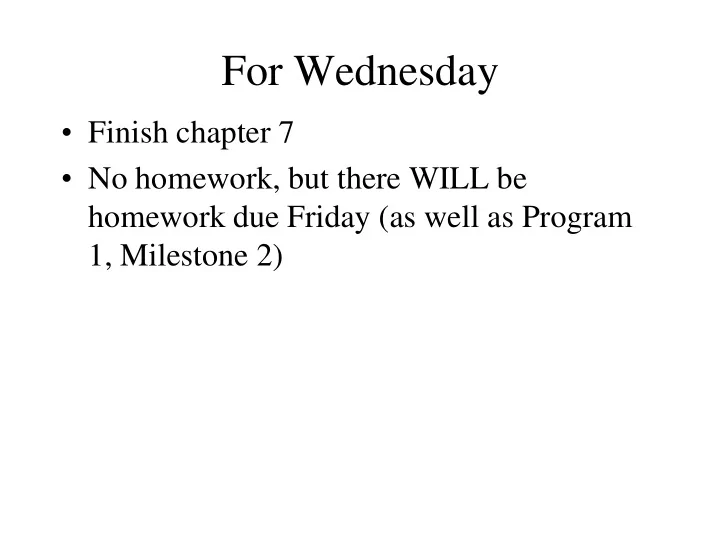

For Wednesday • Finish chapter 7 • No homework, but there WILL be homework due Friday (as well as Program 1, Milestone 2)
Program 1 • Any questions?
Games/Mainstream AI
What about the games we play?
Knowledge • Knowledge Base – Inference mechanism (domain-independent) – Information (domain-dependent) • Knowledge Representation Language – Sentences (which are not quite like English sentences) – The KRL determine what the agent can “know” – It also affects what kind of reasoning is possible • Tell and Ask
Getting Knowledge • We can TELL the agent everything it needs to know • We can create an agent that can “learn” new information to store in its knowledge base
The Wumpus World • Simple computer game • Good testbed for an agent • A world in which an agent with knowledge should be able to perform well • World has a single wumpus which cannot move, pits, and gold
Wumpus Percepts • The wumpus’s square and squares adjacent to it smell bad. • Squares adjacent to a pit are breezy. • When standing in a square with gold, the agent will perceive a glitter. • The agent can hear a scream when the wumpus dies from anywhere • The agent will perceive a bump if it walks into a wall. • The agent doesn’t know where it is.
Wumpus Actions • Go forward • Turn left • Turn right • Grab (picks up gold in that square) • Shoot (fires an arrow forward--only once) – If the wumpus is in front of the agent, it dies. • Climb (leave the cavern--only good at the start square)
Consequences • Entering a square containing a live wumpus is deadly • Entering a square containing a pit is deadly • Getting out of the cave with the gold is worth 1,000 points. • Getting killed costs 10,000 points • Each action costs 1 point
Possible Wumpus Environment Breeze Stench Pit Breeze Breeze Stench Stench Pit Wumpus Gold Stench Breeze Breeze Breeze Agent Pit
Knowledge Representation • Two sets of rules: – Syntax: determines what atomic symbols exist in the language and how to combine them into sentences – Semantics: Relationship between the sentences and “the world” --needed to determine truth or falsehood of the sentences
Reasoning • Entailment • Inference – May produce new sentences entailed by KB – May be used to determine which a particular sentence is entailed by the KB • We want inference procedures that are sound, or truth-preserving.
What Is a Logic? • A set of language rules – Syntax – Semantics • A proof theory – A set of rules for deducing the entailments of a set of sentences
Distinguishing Logics Language Ontological Epistemological Commitment (what Commitment (What exists in the world) an agent believes about facts) Propositional facts true/false/unknown Logic First-order logic facts, objects, true/false/unknown relations Temporal logic facts, objects, true/false/unknown relations, times degree of belief 0…1 Probability theory facts degree of belief 0…1 Fuzzy logic degree of truth
Propositional Logic • Simple logic • Deals only in facts • Provides a stepping stone into first order logic
Syntax • Logical Constants: true and false • Propositional symbols P, Q ... are sentences • If S is a sentence then (S) is a sentence. • If S is a sentence then ¬S is a sentence. • If S 1 and S 2 are sentences, then so are: – S 1 S 2 – S 1 S 2 – S 1 S 2 – S 1 S 2
Semantics • true and false mean truth or falsehood in the world • P is true if its proposition is true of the world • ¬S is the negation of S • The remainder follow standard truth tables – S 1 S 2 : AND – S 1 S 2 : inclusive OR – S 1 S 2 : True unless S 1 is true and S 2 is false – S 1 S 2 : bi-conditional, or if and only if
Vocabulary • An interpretation is an assignment of true or false to each atomic proposition • A sentence true under any interpretation is valid (a tautology or analytic sentence) • Validity can be checked by exhaustive checking of truth tables
Rules of Inference • Alternative to truth-table checking • A sequence of inference rule applications leading to a desired conclusion is a logical proof • We can check inference rules using truth tables, and then use to create sound proofs • We can treat finding a proof as a search problem
Propositional Inference Rules • Modus Ponens or Implication Elimination • And-Elimination • Unit Resolution • Resolution
Recommend
More recommend